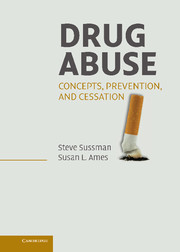Book contents
- Frontmatter
- Contents
- Preface
- Acknowledgments
- SECTION ONE CONCEPTS AND CLASSES OF DRUGS
- 1 Concepts of Drugs, Drug Use, Misuse, and Abuse
- 2 Further Classifications Relevant to Substance Abuse and Dependence
- 3 Types of Drugs, History of Drug Use and Misuse, and Costs of Drug Misuse
- SECTION TWO ETIOLOGY
- SECTION THREE PREVENTION
- SECTION FOUR CESSATION
- SECTION FIVE CONCLUSIONS AND THE FUTURE
- References
- Author Index
- Subject Index
1 - Concepts of Drugs, Drug Use, Misuse, and Abuse
Published online by Cambridge University Press: 18 December 2009
- Frontmatter
- Contents
- Preface
- Acknowledgments
- SECTION ONE CONCEPTS AND CLASSES OF DRUGS
- 1 Concepts of Drugs, Drug Use, Misuse, and Abuse
- 2 Further Classifications Relevant to Substance Abuse and Dependence
- 3 Types of Drugs, History of Drug Use and Misuse, and Costs of Drug Misuse
- SECTION TWO ETIOLOGY
- SECTION THREE PREVENTION
- SECTION FOUR CESSATION
- SECTION FIVE CONCLUSIONS AND THE FUTURE
- References
- Author Index
- Subject Index
Summary
First the man took a drink, then the drink took a drink, then the drink took the man.
– Recovery movement proverbThis first chapter provides a discussion and clarification of various concepts relevant to drug abuse. Although we attempt clarification of many terms and concepts, it is important to note that there are different substantive distinctions and “fuzzy” boundaries between the concepts. For example, distinctions between drug misuse and abuse, and terms such as street drugs or hard or soft drugs are somewhat ambiguous and perhaps dependent on sociocultural contexts. The chapter begins by providing an overview of a definition of a drug, drug use, and drug action and then distinguishes drug use from misuse and provides terms used to refer to drugs that might be misused.
What Is a Drug and Drug Use?
A drug is a substance that can be taken into the human body and, once taken, alters some processes within the body. Drugs can be used in the diagnosis, prevention, or treatment of a disease. Some drugs are used to kill bacteria and help the body recover from infections. Some drugs assist in terminating headaches. Some drugs cross the blood–brain barrier and affect neurotransmitter function. The varieties of drugs that produce a direct or indirect effect on neurotransmitter function in the brain are of primary interest in this book.
Drugs are processed by the body in four steps, and these drugs also may have various effects on each other when used together.
- Type
- Chapter
- Information
- Drug AbuseConcepts, Prevention, and Cessation, pp. 3 - 17Publisher: Cambridge University PressPrint publication year: 2008
- 3
- Cited by



